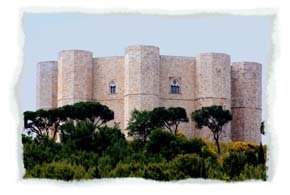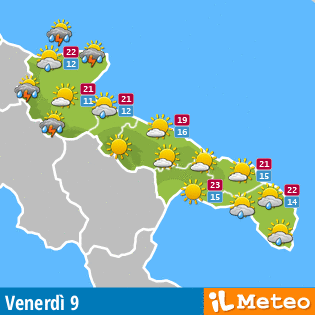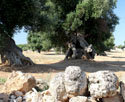Castel Del Monte
Info Castel del Monte
-
Region:
Provincie:
Municipality:
CAP:
Area code:
Surface:
Population:
city hall:
-
Apulia
Barletta-Andria-Trani
Andria
76123
0883
407,86 Kmq
100.130
Piazza Umberto 1
An octagonal castle framed by eight octagonal towers
The castle known as “del Monte” is famous all over the world thanks to its unique octagonal form and its eight towers which show an octagonal form too. The mansion was built by Emperor Federico II di Svevia, between 1229 and 1249, probably as hunting palace. When the Swabian dynasty fell, the castle was used as prison and from the 17th century onward it was leaved unattended and, being uncared, it was plundered and deprived of its marbles and sculptures, becoming a house for shepherds and bandits. In 1876 the palace was redeemed by the Italian State which promoted important restoration works. From a stylistic point of view the castle dates back to the first gothic period of Southern Italy, even if it results from the fusion of Romanesque, Arabic and Norman elements. The entry of the palace is placed on the East side and it is decorated by a beautiful portal where the gothic element represented by the pointed arch is combined with the classic cusp of the tympanum. Every side of the castle is characterized by a single lancet window in the lower part and a double lancet window in the upper part, except the side which looks out on the city of Andria where it is possible to admire a wonderful three-mullioned window: it is a tribute of the Emperor to the city which has always remained loyal to him. A string-course frame adorns the whole perimeter of the outside walls marking the point where first and second floor meet.
Inside we find eight halls for every level; their walls were covered by ancient marbles and they showed beautiful mosaic floors with black and white panels. The eight octagonal towers had a defensive function but they also linked the two floors thanks to snail stairs inside of them. The inner court has an octagonal form too and it is adorned with three French doors, at the level of the first floor, which are decorated with archivolt pillars.
A lot of assumptions have been formulated about the real reasons which induced the emperor Federico II to build a castle like this. Many scholars found some possible associations with esoteric, alchemic and astrologic symbologies, which were deeply linked to the complex personality of Federico II who was a man of culture, keen on art, interested in the Oriental culture, the Islam and the magic doctrines. We find clear evidences in the structure of the castle with the repetition of the number eight, symbol of infinity and of the windrose. Other scholars argue that all measures in the castle can be referred to astral events and to the so called numero aureo (“gold number”), which is a peculiarity of the Egyptian pyramids too.









